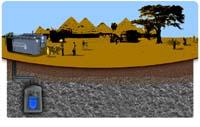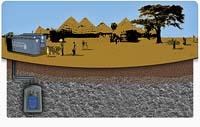A nuclear power plant under the house
2009/01/02 Galarraga Aiestaran, Ana - Elhuyar Zientzia
Hyperion is a company created by the American laboratory Los Alamos. This laboratory is famous for its research in physics, chemistry, engineering, etc., and especially for having built the first atomic bomb there.

The mini-nuclear power plant can also be ideal for desert villages. (Photo: Hyperion)
The nuclear reactor that Hyperion now wants to market can also be used in military installations, as explained on the web. However, this market is limited and is considered suitable for other facilities such as hospitals and university campuses. Thus, according to those of Hyperion, "it is appropriate for anyone who, for security, reliability or economy, wants to be independent of the local energy supply".
In addition, it is considered a good solution for companies or peoples away from places of energy production, such as mines or desert peoples. This last example is illustrated on the website, in which, in a small African village, an installation is shown to water the groundwater, working with the energy of a mini-plant.
Hyperion believes that the reactors they produce are clean, safe and reliable and reasonably priced. They are clean, because they do not emit carbon dioxide into the atmosphere; safe, because it is the most controlled system; reliable, because they work 24 hours a day and seven days a week, even if the day is windy or quiet, sunny or rainy; and cheap, both measured in dollars and in its environmental impact.
Each reactor is the size of a refrigerator and generates the energy needed to supply 20,000 households. They estimate that it will cost twenty million euros, so each household would cost 1,000 euros. It can be transported by train, truck or boat and installed on the ground. The fuel has a duration of five years, after which it must be sent to the Hyperion to change fuel. Meanwhile, it works on its own, no need for more.
Reactor underway
Fuel is a hybrid uranium, that is, enriched uranium that has absorbed a lot of hydrogen. As the uranium nucleus disintegrates from fission it emits neutrons, while hydrogen acts as a moderator, that is, it decreases the speed of neutrons and dampened neutrons divide other uranium nuclei. This prevents the breakdown of the reaction chain and takes advantage of the heat generated in the reaction chain to supply energy to the facilities.
In case of excess heat, the system itself would paralyze the chain of reaction, thus avoiding problems. Radioactive waste is also controlled by the total closure of the reactor. Therefore, once transferred to the change, it would be stored in it correctly until it ceased to be radioactive.
Hyperion has everything ready. Now you are studying the market and looking for customers. They say that an Eastern European group intends to buy six copies and that the Czech engineering company TES could buy 44. However, they do not expect the first to sell before 2013.
For this, they will surely have to overcome several obstacles. In fact, mini-plant technology may be fully developed, but people are also very likely to pick it up with suspicion. Or anyone knows, everyone would accept a nuclear reactor under the house.
Published in Gara

Gai honi buruzko eduki gehiago
Elhuyarrek garatutako teknologia






